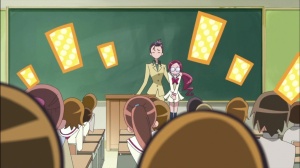 Switching from looking up Japanese words in a Japanese-English dictionary to looking them up in a Japanese-Japanese dictionary is an important step. When and how one takes it, and whether one takes it all at once, is something I plan to write about very soon.
Switching from looking up Japanese words in a Japanese-English dictionary to looking them up in a Japanese-Japanese dictionary is an important step. When and how one takes it, and whether one takes it all at once, is something I plan to write about very soon.
In fact, I planned to write about it today, but I got rather carried away on the Hawk Question.
But the reason I did is that I think it is very important. It is a kind of thought experiment, and one I first began thinking through a long time ago. To be honest I thought at first that it was an argument against early-ish J-J definitions. But as I thought it right through I realized that it was an argument for them.
Let me take you along the road I followed:
Suppose I wanted to look up the word タカ without using any English sources (it means “hawk”. I actually learned it from watching the Japanese Heidi anime).
Assuming the English word was never thrown in (which it might well be at some point) I could get through a ton of ornithological information, if I were determined enough, and end up either:
A) Still not knowing what bird it was
or
B) Saying “oh, it’s a Hawk” – in other words ending up with the result I would have gotten right off with a J-E dictionary.
Now even if my moment of revelation had come in Japanese. I would still have thought あら、それはhawkなのね!Because I have no other way of pinpointing the bird.
This is especially so because my relation to hawks is largely verbal and symbolic. I have no very clear idea what distinguishes a hawk from some other bird of prey. But the word hawk has all kinds of associations of a verbal and symbolic nature. Hawkeye, hawkish, “a hawk making lazy circles in the sky”. I don’t really know what a hawk looks like. But the word is rich in associations.
I know what 犬 is without reverting to the word “dog” because I am familiar with 犬 nature. But if, in researching タカ, I never encounter the word “hawk”, all I will know is that it is some bird of prey.
Now this could sound like an argument against strictly J-J definitions. But the more I think about it, the more I see that it is an argument for them.
It is actually better, provided I get enough cultural immersion, not to know the word “hawk” in relation to タカ. Whether it can be avoided in the long term I don’t know, but this is really a thought experiment.
If I never know that タカ means what English means when it says “hawk” (a bird I know very little about except on a verbal level), what will happen?
At first I will know very little more than that it is a bird of prey. The one I saw in Heidi that made quite an impression on her. So I will know that it is somehow a significant and impressive bird. A name to conjure with, rather than, say, a “lesser spotted marsh tern” (yes I did make it up, but you get the point). I might read some extra ornithological information, but I won’t take it in, any more than I would in English.
But, I already have one cultural association with the word タカ. It comes from Heidi. I also know it isn’t a カラス. I met a カラス very early on in my Japanese journey when it flew into the window in Karigurashi no Arietty, the first Japanese anime I watched with Japanese subtitles. Later I met them in the flesh in Japan and marveled at how the Japanese ones really are as big as the ones in Arietty, and really do haunt Shinto shrines, as they do Rei’s shrine in Sailor Moon. If I hadn’t known the English word for a カラス I would now have a standard of comparison for both birds.
But let’s stick with タカ. I don’t know the English name, so I can’t bring in all the English language associations of “hawk”. I do know vaguely how it looked in Heidi (my visual memory isn’t great); more importantly, I know its emotional impact on Heidi. I know it is a bird of prey from both Heidi and the J-J dictionary. I know it isn’t a カラス. And at this stage that is about the limit of my possible knowledge. Just as it would be if I were a Japanese child.
What is going to happen as I get more cultural immersion exposure is that I will add to this other encounters with タカ. I will read about them in books, see them in anime, note (often subconsciously) the “tone” in which people use the word. I will also encounter expressions that use タカ.
Instead of importing all the English associations of “hawk” and grafting them onto タカ, I will be gradually building my relation to the Japanese word and learning to see, hear and feel it the way a Japanese person does.
And this, in miniature, is why J-J definitions are important. No two words in different languages mean the same thing. People argue that “water” means the same as 水. In a way that is right but in another way it isn’t. 水 refers to the substance we all drink and swim in, certainly. But the word also has literary/linguistic/cultural associations and colorings that differ from those of “water”, and vice versa.
As soon as we get beyond the simplest words the differences deepen. Oishii does not mean “delicious”, for example. There is no English word that exactly expresses what oishii does mean.
Hawk and タカ refer to the same bird, but unless you happen to be an ornithologist, that is not what is really important about the two words. What really matters are their linguistic/emotional/cultural reverberations.
If you want to learn Japanese in a polyglot “fluent in three months” way, none of this matters. If you want to learn “business Japanese” (only), none of this matters.
But if you want to learn Japanese from the inside, to feel it in its true “weight” and “coloring” – in other words, to know what Japanese words mean, not what their nearest English equivalents are – then this is very important indeed.









